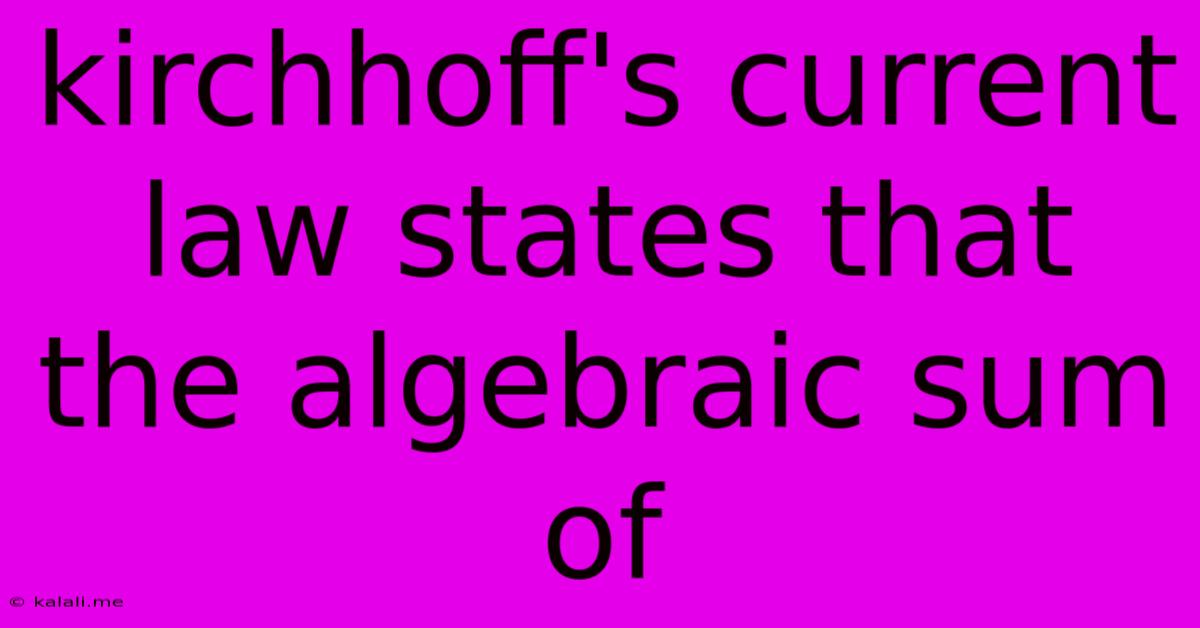Kirchhoff's Current Law States That The Algebraic Sum Of
Kalali
Jun 13, 2025 · 3 min read

Table of Contents
Kirchhoff's Current Law: Understanding the Algebraic Sum of Currents
Kirchhoff's Current Law (KCL), also known as Kirchhoff's First Law or Kirchhoff's Junction Rule, is a fundamental principle in circuit analysis. It dictates how current behaves at junctions or nodes within an electrical circuit. This article will delve into the core concept of KCL, explaining what it states, how it works, and its implications in practical circuit analysis. We'll also explore some examples to solidify your understanding.
What Kirchhoff's Current Law States
At its core, Kirchhoff's Current Law states that the algebraic sum of currents entering and leaving any node (junction) in an electrical circuit is equal to zero. This means that the total current flowing into a junction must equal the total current flowing out of that junction. Think of it like a water pipe system: the amount of water entering a junction must equal the amount leaving, assuming no water is lost or gained within the junction itself.
This seemingly simple statement has profound implications for analyzing complex circuits. It allows us to establish relationships between currents in different branches of a circuit, which is crucial for solving circuit problems and understanding current distribution.
Understanding the "Algebraic Sum"
The term "algebraic sum" is key. It implies that the direction of current flow matters. We assign a positive sign to currents entering a node and a negative sign to currents leaving a node (or vice versa, as long as you remain consistent). When we add up these currents, considering their respective signs, the total sum should always be zero.
This convention helps account for the conservation of charge – a fundamental principle in physics. Charge cannot be created or destroyed within a node; it simply flows through. KCL ensures that this principle is upheld in our circuit analysis.
Applying Kirchhoff's Current Law: A Practical Example
Consider a simple circuit with three resistors connected to a single node. Let's say current I1 flows into the node, and currents I2 and I3 flow out of the node. According to KCL:
I1 - I2 - I3 = 0 or equivalently I1 = I2 + I3
This equation tells us that the current entering the node (I1) is equal to the sum of the currents leaving the node (I2 and I3).
KCL and Circuit Analysis Techniques
KCL is an essential tool in various circuit analysis techniques, including:
- Node Voltage Analysis: This method uses KCL to write equations relating the currents at each node in a circuit, which are then solved to find the node voltages.
- Mesh Current Analysis: While primarily using Kirchhoff's Voltage Law (KVL), mesh analysis indirectly utilizes KCL by implicitly accounting for current conservation at junctions.
- Superposition Theorem: This theorem, used to analyze circuits with multiple sources, relies on KCL to determine the individual contributions of each source to the overall circuit currents.
Limitations and Considerations
While incredibly powerful, KCL has limitations:
- Idealized Model: KCL assumes ideal conditions, neglecting factors like stray capacitance or inductance that might affect current flow.
- AC Circuits: In AC circuits, the concept remains valid but requires careful consideration of phasors and complex numbers.
Conclusion:
Kirchhoff's Current Law is a cornerstone of electrical circuit analysis. Understanding its principles—the algebraic summation of currents at a node and its implications for charge conservation—is essential for anyone working with electrical circuits. By mastering KCL and applying it effectively in conjunction with other circuit analysis techniques, you can confidently analyze and solve complex electrical circuits.
Latest Posts
Latest Posts
-
Greater Than Less Than And Equal To Calculator
Jun 14, 2025
-
Which Of The Following Is Technically Not A Programming Language
Jun 14, 2025
-
How Many Lines Of Symmetry Does The Letter H Have
Jun 14, 2025
-
How Do You Become More Mature
Jun 14, 2025
-
Moving A Body Part Toward The Midline
Jun 14, 2025
Related Post
Thank you for visiting our website which covers about Kirchhoff's Current Law States That The Algebraic Sum Of . We hope the information provided has been useful to you. Feel free to contact us if you have any questions or need further assistance. See you next time and don't miss to bookmark.